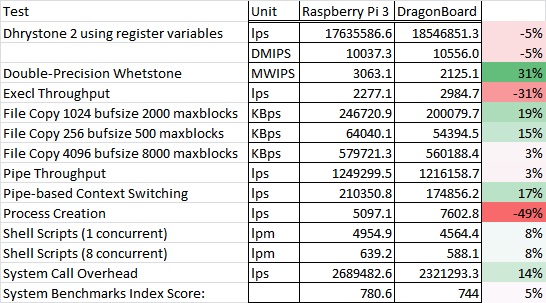We talk a lot about single board computers– there is a huge variety out there, and they all have differing capabilities and costs, so how should we go about finding the right one for our needs? I decided to run some numbers to get a solid starting point on performance in computing tasks. Looking at these stats should help you understand what you can accomplish with each board and which ones are best suited to your project.

To sum up the results quickly, more money results in more computing performance overall with the Intel Joule sitting at the top of the pack – but that isn’t the whole story. Among the boards less than $100, the top performer is the Raspberry Pi 3 with the Dragonboard close behind. For reference when looking at the results, lots of integer math can be accomplished in floating point data types, and floating point math is much more important to graphical systems while integer math can be lower latency but sacrifices precision.
The Joule’s top level performance opens up the possibilities of working with 4k video inputs and outputs while using advanced algorithms to make decisions and process through heaps of data. The Jetson is not far behind the Joule in DMIPS but only has about 60% of the integer math performance, meaning when you need low latency calculations that integer operations excel at you will suffer a decent performance hit. It also features half the onboard RAM.

Among the more affordable boards, the top performer is the Raspberry Pi 3 based on the stout Broadcom BCM2837. The Pi outperforms the Dragonboard by 30% in the Whetstone benchmark and is about even in the Dhrystone benchmark with their overall benchmark score differing by less than 5%. One area the Dragonboard does excel in is availability; the Snapdragon 410c that powers the board is available as the 410e for incorporation into your system if you choose to spin your own board, and because it has an ‘e’ suffix, that means Qualcomm guarantees 10 years of availability. The Beaglebone Black is unique; it is available in an industrial temp version, but only having a single core significantly hinders its capabilities, and even when compared on single core performance, its floating point performance is lacking.
The numbers don’t always tell the whole story, but they give a decent starting point when working to determine which single board computer you should use for your next project. You can go for the maximum performance with something like the Joule or save some money and work with a board like the Raspberry Pi 3 or Dragonboard 410c. Each SBC comes with its own capabilities, and one isn’t perfect for all applications.
Here are my complete results so you can make the best choice for your next project.
Benchmarked Boards


